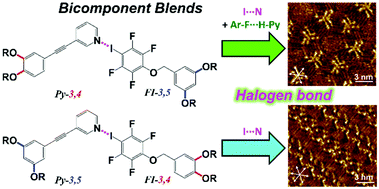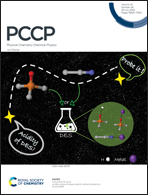Halogen bond-directed self-assembly in bicomponent blends at the solid/liquid interface: effect of the alkyl chain substitution position†
Abstract
The fabrication of well-organised molecular assemblies on surfaces is fundamental for the creation of functional molecular systems applicable to nanoelectronic and molecular devices. In this study, we investigated the effect of substitution positions of alkyl chains on the formation of halogen-bonded molecular networks. For this purpose, building blocks with different head groups (i.e., pyridine (Py) or tetrafluoro-iodobenzene (FI)) were substituted with hexadecyloxy chains at either the 3,4- or the 3,5-positions. The two-dimensional assembly of each compound as a single-component system was studied using scanning tunnelling microscopy (STM) at the highly oriented pyrolytic graphite (HOPG)/1-phenyloctane interface. All compounds displayed linear structures in which the alkyl chains were aligned along one of the HOPG axes. In the exceptional case of FI bearing hexadecyloxy chains at the 3,5-positions (denoted as FI-3,5), hexagonal arrays were tentatively formed owing to the triangular molecular arrangement induced by halogen bonding. A bicomponent blend of Py-3,4/FI-3,5 (1 : 1 molar ratio) enabled the formation of a honeycomb structure, whereas that of Py-3,5/FI-3,4 (1 : 1 molar ratio) produced a rectangular assembly that was periodically arranged in a zig-zag fashion. Finally, based on the observed blend ratio dependence, the formation of these different two-dimensional structures by variation in the substitution positions of the alkyl chains was discussed in terms of molecule–molecule and molecule–substrate interactions.



 Please wait while we load your content...
Please wait while we load your content...